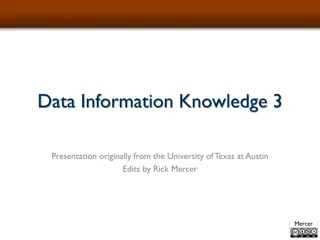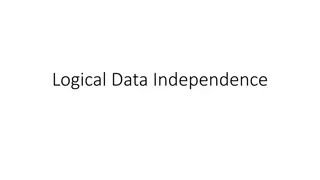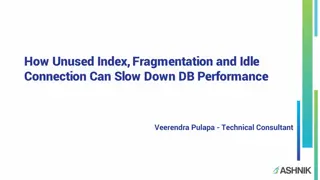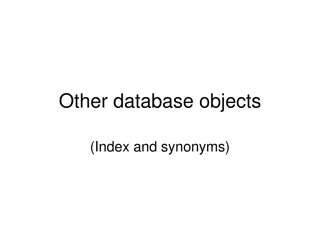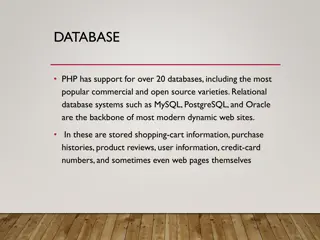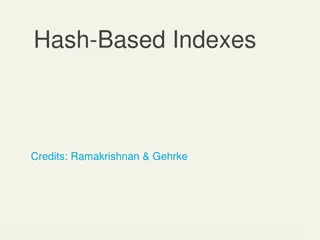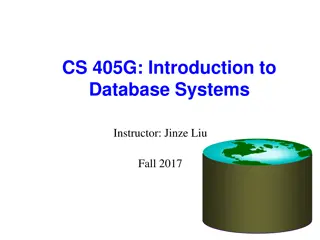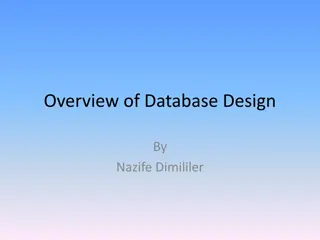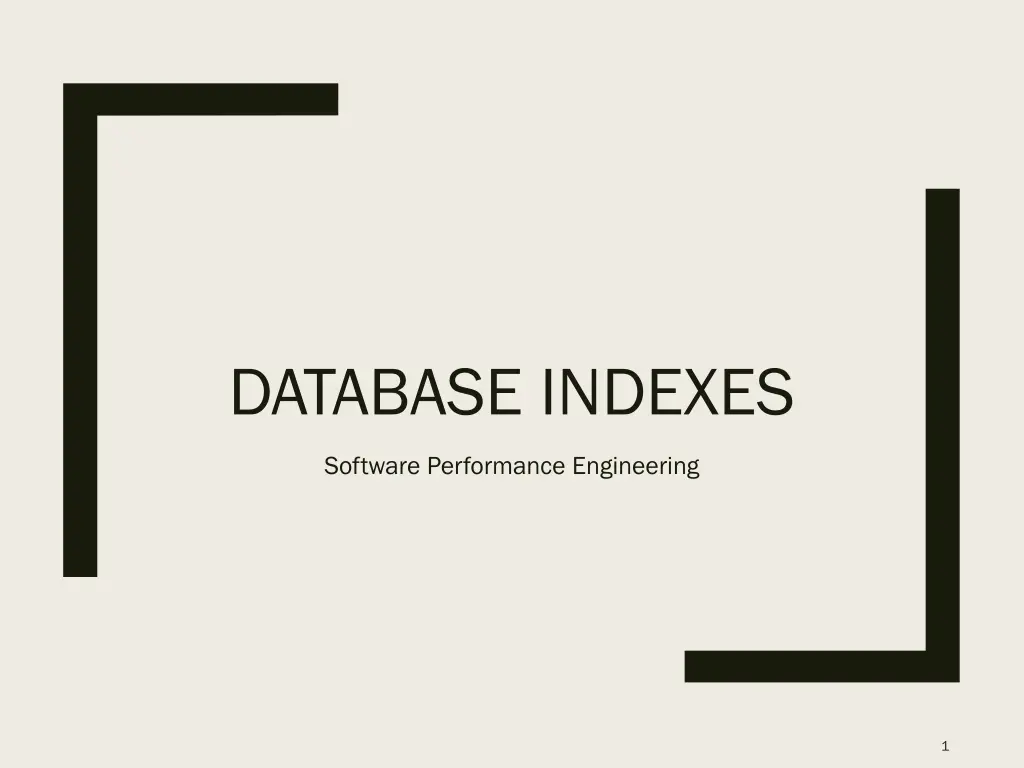
Understanding Database Indexing Techniques
Learn about database indexing, including hash tables and B-trees, essential for optimizing performance and enabling fast lookups in software performance engineering. Explore the differences and use cases of unique vs. non-unique indexes, partial vs. multi-column indexes, and the operations involved in B+ trees.
Download Presentation

Please find below an Image/Link to download the presentation.
The content on the website is provided AS IS for your information and personal use only. It may not be sold, licensed, or shared on other websites without obtaining consent from the author. If you encounter any issues during the download, it is possible that the publisher has removed the file from their server.
You are allowed to download the files provided on this website for personal or commercial use, subject to the condition that they are used lawfully. All files are the property of their respective owners.
The content on the website is provided AS IS for your information and personal use only. It may not be sold, licensed, or shared on other websites without obtaining consent from the author.
E N D
Presentation Transcript
DATABASE INDEXES Software Performance Engineering 1
Database Indexes A database index is a data structure that enables fast lookups Trade: gain speed vs. cost of size Trade: gain read vs. cost of updates Alternative is a full table scan fast lookups Also: aids in sorting sorting data Also: enforce uniqueness uniqueness constraints Common algorithms: hash tables, b-trees, and more Usages Unique vs. Non-unique Partial indexes Single column vs. Multi-column 2
Hash Tables Essentially, an array of linked lists with a hashing function Given a key, provide the disk location of the row key hash(key) index of the array traverse linked list Hash tables provide provably constant time lookup Hash tables are memory-friendly Linked lists can be malloc d at random Scaling & rebuilding is not very expensive But! Hashes are generally good for single, unique lookups Can t speed up ORDER BY Can t search for inequalities Most DBMS s recommend B-tree instead anyway Images from Wikipedia 3
B-trees NOT the same thing as binary tree, rather an n n- -ary generalization of a binary tree Most common subtype for databases: B+Tree A commonly-used, all-purpose indexing algorithm High branching factor b, so high fanout Structure of a B+tree Single root node Multiple layers of intermediate nodes One layer of leaf nodes Leaves maintain a sorted linked list for quick traversal Maintain rules about how many children per node and how many items per node In practice: Nodes are usually a byte-sized array A 3-level B-tree handles 2553=16.6 million records You can usually cache the root and first layer anyway, so most reads only involve 1-2 disk reads ary tree tree, a B+Tree image from Wikipedia 4
B+Tree Operations Search Start at root, traverse to the tree based on inequality Constant-time searches on a given node (usually 255) Only looking up a few nodes Once you find the first, follow the linked list to get the rest of the range Insert Do a tree search to determining bucket If the bucket is full, split the bucket into a new one Continue splitting up and down until you have enough room Re-balancing only impacts max of 2 leaves and some parents Bulk-loading Sort the data first Load in data from the leaves, creating and updating root as you go Cheaper than many inserts at once 5
Example B+tree Inserted 40 7
Unique vs. Non-Unique Indexes Most database index algorithms support non-unique indexes Hashes, B+trees, etc. But the implementation is slightly different Database indexes will always perform better if they KNOW that the index is intended to be unique Add this as a constraint to your table Column constraint on the CREATE TABLE or ALTER TABLE Or CREATE UNIQUE INDEX instead of CREATE INDEX 8
Multidimensional Indexes Some data is inherently multidimensional ( data cubes ) e.g. latitude & longitude, or customer purchase data Two problems Nearest-neighbor queries: Find closest bathroom to this lat-long Partial match queries, Find all bathrooms near this lat Partitioned hash tables: modify the hash function to take in multiple arguments Can t handle range queries Grid files: generalization of hash tables Multi-dimensional array Combine array indexes into ranges to be more sparse B+tree: combine the conditions together Mixed values on the leaves Order of columns can matter in how you declare them But there are specialized algorithms for this 9
Multidimensional Indexes (2) kd-Trees K-dimensional search trees Binary search tree, alternating layers between dimensions Partial queries: square-root in number of leaves, not logarithmic Not automatically balanced Quad trees Each node represents a k-dimensional cube Each face of the cube represents a boundary range with 2k children Named after the 2-dimensional case: branching factor of 4 R-Trees In the spirit of B-trees, with some rectangle intersection Two rectangles that don t intersect won t intersect any smaller rectangles contained within Group objects on the multi-dimensional space by minimum bounding rectangles Create a tree structure around that 10
Multi-column Indexes In practice, the way we create multi-dimensional indexes is to simply an index on multiple columns CREATE INDEX locations_on_lat_lon ON locations(lat,long); However, many will default to B+tree and won t make use of how it will be queried Carefully test and choose your indexes on this one Again, go to the docs for recommendations on this e.g. PostgreSQL The GiST index is a mixture of various algorithms designed for multi-dimensional situations SELECT * FROM places ORDER BY location <-> point '(101,456)' The GIN index is built for layered data and document-oriented storage (e.g. JSON) where data is repeated a lot BRIN (Blocked Range Indexes) are better for partially-sorted data e.g. MySQL originally had these as extensions 11
Bitmap Scans (Not to be confused with Bitmap Indexes slightly different thing) Most databases have the ability to combine index lookups Conduct the lookups and put them into a bit vector Run AND/OR/XOR on the vectors as needed This is an alternative to creating multi-column indexes Which is faster? Multi-column or bitmap scans of single- column? Depends. This all come down to the query planner This can help understand EXPLAINs though 12
Partial Indexes You can also create indexes on some, but not all, data, e.g. CREATE INDEX access_log_client_ip_ix ON access_log (client_ip) WHERE NOT (client_ip > inet '192.168.100.0' AND client_ip < inet '192.168.100.255'); Smaller indexes are more likely to cached and faster to traverse Avoid indexing common values Avoid indexing uninteresting values (e.g. unbilled ) Good way to build in your knowledge of the table s distributions Also this is great way to check for existence without hitting the table itself, especially if it s unique (called an Index-only scan .) 13
Index-Only Scans In many database systems, If the query includes onlythe columns in an index, then Only the index gets looked up For example (from PostgreSQL docs) Suppose we have a table t with x,y, and z. x and y are indexed in a single index, z is not SELECT x, y FROM t WHERE x = 'key'; # YES! INDEX-ONLY! SELECT x FROM t WHERE x = 'key' AND y < 42; # YES! INDEX-ONLY! SELECT x, z FROM t WHERE x = 'key'; # No. Not index-only SELECT x FROM t WHERE x = 'key' AND z < 42; # No. Not index-only Again, this comes out in EXPLAIN as to whether or not you are expecting it Drawback: space! Check the docs for your system 14
Expression Indexes You can also make an index on a manipulation of the data SELECT * FROM people WHERE (first_name || ' ' || last_name) = 'John Smith'; This is handy for situations where you: Don t want to create duplicate data (e.g. full_name ) Will be searching on the full data a lot In practice, this feature is finicky One small change to the schema means the index goes unused Can be found using EXPLAIN 15
Tips for Indexes Make sure the database query planner has the right information for planning e.g. PostgreSQL s ANALYZE counts data distributions On small tables, sometimes using an index is slower. A query planner (usually) gets this right Some indexing structures need upkeep from inserts Rebuilding an index on an existing table vs. from an empty table e.g. PostgreSQL s CLUSTER table USING index Some indexes have concurrency concerns Some index data structures don t take concurrency very well Rebuilding the index sometimes causes big locks Read the docs! Common wisdom that we should test in future lab experiments: Indexes also benefit from the NOT NULL constraint Integers index faster than text Using both a single-column index and a multi-column index can see a benefit Name your indexes. This will make maintainability and EXPLAINS easier. Have a common convention, too. E.g usernames_on_emails 16







